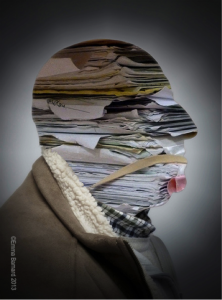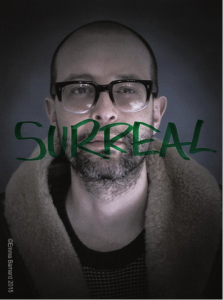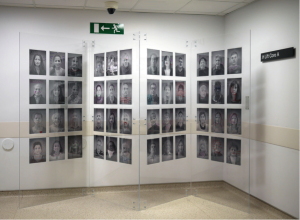Emma Barnard MA (RCA)
___________________________________________________________________
PATIENTS AS PEOPLE – an Exhibition by Emma Barnard in collaboration with consultant surgeons and patients within the ENT department, Whipps Cross University Hospital, Barts Health NHS.
As a fine artist working predominantly within the field of photography, video and sound, I have for the past few years been resident at Whipps Cross University Hospital, Barts Health Trust, collaborating with ENT and more recently Dermatology consultant surgeons investigating what it means to be a patient within the NHS. My focus is on the human condition rather than diagnosis, and on how one might feel as a patient in a clinical, alien environment.
Four years ago, I found myself surrounded and engulfed by the pastel walls and polished floors of the hostile, medical space, as I was guided by the yellow line that led me to my appointment with an ENT consultant. Back then I was just another terrified patient sitting in a visually depleted waiting room, anxiety heightened by the wait itself. Two hours later, I was seen by the consultant when, hanging on to his every word, my auditory senses were heightened over visual ones – thinking just tell me it’s nothing serious…please! He did, I relaxed, and then without too much thought proceeded to blurt out ‘Has an artist ever done any work on patient experience?’ I subsequently wondered why I had voluntarily offered to spend time in a place that most people avoided at all costs.
The process that followed was not easy. In particular, convincing the relevant people at the hospital who believed that having an artist on site involved setting up an easel in a packed to the gills clinic, brandishing a palette and being creative with a paintbrush, took a lot of persuading.
‘Without your medical file you don’t exist within this environment’. First spoken to me by the ENT Head and Neck surgeon Michael Papesch FRACS, these powerful and thoughtful words triggered the name for the project, Patient As Paper. It was not long before the French philosopher Michel Foucault and his book The Birth of The Clinic came into view.
‘When medicine becomes the only social language, the distinction between the doctor and the patient gets more explicit. Their perception of each other becomes hierarchical. In this relationship, the physician is the healthy, wise and authoritative one; whereas, the patient is perceived by the doctor as sick and powerless, even though the doctor may also get sick sometimes. This is what Foucault calls the “medical gaze”.’
Hsuan and Lincoln 2007: 23
Foucault says: ‘Facilitated by the medical technologies that frame and focus the physicians’ optical grasp of the patient, the medical gaze abstracts the suffering person from her sociological context and reframes her as a “case” or a “condition.’
Hsuan and Lincoln 2007: 23
Patient As Paper – CType digital print 2013
As Nancy-Scheper Hughes exemplifies in her article ‘The Mindful Body’, ‘the doctor searches for the “real” cause of the headache, ignoring the social and personal implications of the illnesses with which the patient deals. Thus, through the discourse of medicalization, the sickness emerges as “a form of communication – the language of the organs – through which nature, society and culture speak simultaneously.‘
Scheper-Hughes and Lock 1987: 3
Patients are seen as the voiceless, lost in a system that reduces them to their diagnoses. Having previously been an advocate for various other groups, such as hard to reach NEETS (youth who are not in employment, education or training), Patient As Paper presented an incredible opportunity for me as an artist to once again make the unseen visible through art, by giving patients a voice. I am interested in using art to explore the patient’s perspective on being in hospital, and their emotional response to becoming a product of investigations and treatments. Patients may feel overwhelmed and disorientated by the hospital environment, and may experience loss of control. I am also interested in what doctors experience when looking after patients, particularly when this is emotionally challenging.
After a trail of recommendations, we were fortunate to meet Chris Mc Manus, Professor of Psychology and Medical Education at UCL, who wrote the following:
‘“Patient as Paper” explores photographically the meanings of silent biomedical artifacts such as notes, scans, micrographs and surgeons’ theatre drawings (be they on paper or skin). By inverting a patient and their notes, using superimposition and image-processing, photography forces a critical reflection on being a patient in the foreignness of hospitals, and on the complementarity of patients’ and surgeons’ visions of each other, as objects and people.’
Discussion dictated my next step. Following observation of the patient and surgeon consultation, I presented patients with an opportunity to express their reality, thoughts and feelings through art. In an ENT department, the face, the most potent visual correlate of the person, and personal identity are especially pertinent. The photographic portrait, taken after some discussion with the patient, is printed out and the person is encouraged to note what has impacted them the most about being a ‘patient’. Is there a defining thought, word or image? Proving that human beings can never just be a number, each individual is unique, and no two individuals have ever written or drawn the same content.
Emma Barnard working with patient Lee Anderson 2015
‘As a doctor I wanted to look at patient experience and different ways of understanding what the patients are going through mentally and emotionally and not just physically. Working with Emma allowed us to investigate this through the medium of fine art photography as a radically different way (from a medical perspective) of assessing patient experience. We as doctors are often subject to focusing on the science of medicine, despite our best intentions of treating patients as people. The core of this project is about the need for establishing this human connection as well as understanding what it means to be a patient.
To reflect upon these images invites the doctor and other healthcare professionals to consider what the patient is expressing about their care. Some images are very literal, others less so. It is not so important that the viewer understands exactly what the patient themselves is thinking. The challenge for us as health care providers is to allow ourselves the opportunity to reflect on these images and thereby consider, in a novel, visual and artistic way, how the patient experience can affect us all.’
Mr Michael Papesch FRACS ENT Head and Neck Consultant Surgeon
‘Working alongside Emma has certainly changed my view of the patient consultation for the better. Many of the actions, words and phrases that are commonplace to me seem unusual or even shocking to a non-medically trained professional such as Emma. Emma articulates these thoughts and I gain greater insight into how the patients’ must be feeling. The images created by the patients never fail to amaze me. We all need to look at how we interact with patients during difficult and sometimes upsetting consultations. This kind of work reminds us that we are dealing with real people with real thoughts, fears and emotions and as such it has great value’.
Mr Paul Stimpson FRCS (ORL-HNS) ENT Head and Neck Consultant Surgeon
Now that I had secured this invaluable patient-centred work, it was important to give these people a voice in a more public way. Thus, the Patients As People exhibition was realized. Displaying artwork in a hospital setting comes with incredibly complex rules and regulations. Individual framed portraits on walls can be tricky, something that years of working with galleries and various venues had taught me. I sought inspiration from my biomedical environment and the many tests some of the patients had to endure in their pursuit of ‘getting better’. The idea was a play on the word and function of the X-Ray, a vision of one’s internal world. The exhibition itself could similarly be seen as a reflection of what was taking place within patients’ minds. A free-standing display was designed, containing several pockets where patient portraits could be contained.
Patients As People exhibition – George V Wing, St Barts, NHS Barts Health
Two and a half years ago, the launch at Whipps Cross University Hospital took place. Today, the exhibition is currently installed at its tenth venue, St Peters Hospital, Surrey, having toured the country to include the Department of Health London, Lancaster University and the NHS Leadership Academy in Leeds. One of the hosts Justine Thompson, Patient and Public Participation Lead, Strategic Clinical Network and Senate (East of England) Cambridge comments:
‘From the woman who is ‘boiling over’, to the young man who has totally obliterated his own face, every photograph in this powerful exhibition stops us in our tracks with its raw communication of human emotion.
Some of the pictures show outward serenity – but the self-authored graffiti often tells another story. These photographs are a graphic reminder that every person’s health story is as unique and individual as they are and that every encounter with a health care professional is likely to be an unwelcome voyage into the unknown. This is essential viewing to reconnect us all to the core of our own humanity.’
After a successful launch at St Peters Hospital the exhibition will remain there until the move to Ashford Hospital in September, launch date 19th October. If you would like to attend the launch, please contact: Giselle Rothwell on giselle.rothwell@asph.nhs.uk
Heather Caudle, Chief Nurse who commissioned the exhibition to be installed at Ashford and St Peters writes ‘Seeing the person before the patient’: http://www.ashfordstpeters.nhs.uk/about-us/message/1269-seeing-the-person-before-the-patient
Future bookings are now being taken, if interested please contact Emma through one of the following:
Web – www.emmabarnard.com
Twitter – @PatientAsPaper
FB – Emma Barnard Artist
The Patient As Paper project is currently seeking funding/sponsorship. If you would like to contribute to this exciting initiative please contact Emma.
Other artwork, which explores medicine and religion from the Patient As Paper project, is being shown in the following touring exhibition:
‘If Yesterday Were Today’
Tuscany – 11th – 18th July
Berlin – September 12th – 20th
London – 3rd – 6th December 2015
References
Hsuan L. Hsu and Martha Lincoln, Winter 2007, Biopower, Bodies . . . the Exhibition, and the Spectacle of Public Health’, Discourse, Volume 29, Number 1
Nancy Scheper-Hughes and Margereth M Lock, 1987, The Mindful Body: A Prolegomenon to Future World in Medical Anthropology, Medical Anthropology Quarterly 1 (1)
___________________________________________________________________________


